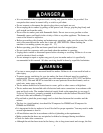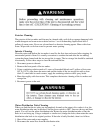
9
· To ensure proper ventilation for your ice maker, you need keep the front of the unit completely
unobstructed.
· Choose a well-ventilated area with temperatures above 50ºF (10ºC) and below 100ºF (38ºC).
This unit MUST be installed in an area protected from the elements, such as wind, rain, water
spray or drips.
· The unit should not be located next to ovens, grills or other sources of high heat.
· Installation of the ice maker requires a cold water supply inlet of ⅜” (9,5 mm) soft copper
tubing with a shut-off valve.
· The ice maker requires a continuous water supply with a minimum pressure of 15 psig and a
static pressure not to exceed 80 psig. The temperature of the water feeding into the ice maker
should be between 41ºF (5ºC) and 90ºF (32ºC) for proper operation.
·
In general, it is always a good idea to filter the water. A water filter, if it is of the proper type,
can remove taste and odors as well as particles.
·
The ice maker must be installed with all electrical and water connections in accordance with
state and local codes.
·
The ice maker and bin should be located on a firm and level surface. It is important for the ice
maker to be perfectly level for proper operation; otherwise water may not flow properly
through the evaporator (ice mold). Ice production will be less than expected and operation will
be noisy.
The feet of most bins can be rotated to adjust the height if necessary. Follow instructions
accompanying the bin you purchase.
Electrical Requirements


















